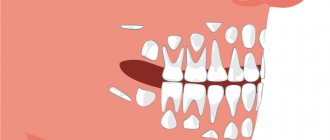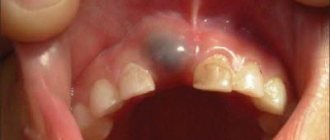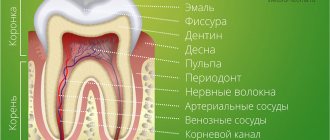In case of complete or partial absence of teeth, one of the main treatment methods is the production of a complete or partial removable denture. At the same time, despite the fact that from an aesthetic point of view, at first it can completely satisfy the patient, from a physiological point of view there is a certain range of problems that it does not solve in any way and which are worth paying attention to.
Improving facial aesthetics is the only problem that a removable denture can solve. However, this effect is temporary; the patient must periodically reline it.
Let's consider the main consequences of tooth loss in patients. Spend 5-10 minutes reading this material, the information contained in it can be very useful.
Why does bone tissue decrease when teeth are missing?
So, let's talk a little about the causes of bone loss.
One of the problems is the so-called bone deficiency. It is very important to understand that bone is the same living tissue of the body as all other organs, although it is very hard and has its own laws of life, growth time, etc.
The roots of the teeth are located in the bone of the alveolar process on the upper jaw and in the alveolar part on the lower jaw, they provide the retention and stability of the teeth. When we talk about bone deficiency, we mean the partial or complete absence of that bone tissue.
The alveolar bone has such a structure and structure that in the absence of teeth it simply dissolves or resorption occurs. Also, bone loss can occur with periodontal disease, even in the presence of teeth.
Removable dentures greatly increase the rate of alveolar bone resorption due to large or improper pressure on the gum and bone, pressure for which they were not designed.
All this can lead to the fact that there will be nowhere to place dental implants.
Installation of a bridge
The use of fixed orthodontic structures is a modern way to fill wide gaps in the dentition.
In order for the prosthesis to be securely fixed, it is necessary to have supporting dental units. It is on them that the entire structure is attached.
The best option is to make a bridge from metal ceramics. The service life of this design is 7 years or more. At the same time, the bridge retains its original shade and does not differ from adjacent natural teeth.
Contraindications to installing a prosthesis on rare teeth:
- Acute periodontitis.
- Parafunctions of the masticatory muscles.
- Insufficient height of supporting teeth.
If there are absolute contraindications, the doctor makes a decision regarding the advisability of using a different treatment method.
Prices for treatment of caries of anterior teeth in Moscow
The price for treating caries of anterior teeth largely depends on the technique used. Standard therapy with the installation of a light filling will cost from 5,800 rubles. But prices for restoration start at 12,500 rubles. Treatment costs approximately the same without an Icon drill. Treatment of pulpitis on the front teeth involves cleaning the canals, which will add several thousand more to the total amount. If the tooth is seriously damaged and installing a filling is impossible, get ready for serious expenses. The average cost of a ceramic crown is from 25,000–30,000 rubles, and turnkey implantation will cost at least 55,000–100,000 rubles for the installation of one implant.
Several stages of caries development
How does the initial stage of caries manifest?
The first stage is the initial stage of caries - when a chalky stain appears on the tooth, such a concept used to be present. At this point, the tooth enamel loses its transparency and becomes completely white. Hence the name - as if drawn with chalk. This carious spot may become pigmented or darken. In this case, it is believed that caries has stopped in the enamel and the destruction process no longer proceeds. This is a controversial theory, since only a dentist can assess the condition of a tooth.
What are caries spots? According to the modern classification, these are enamel caries and dentin caries.
Previously, there was such a classification: spot stage, superficial, medium and deep caries. But regardless of classification, any caries is worth treating.
The second stage of caries after the stain is enamel caries
When the carious process occurs only in the tooth enamel, this is superficial caries.
The third stage of caries - a dark spot on the tooth
If a patient comes and says that I react to sweets, he will have the most favorable treatment outcome
The third stage or middle caries looks like a dark spot on the tooth. In this place, the enamel has already been destroyed, and the disease goes deep into the tooth. This occurs when dentin caries appears.
Diagnostics
After the examination, the orthodontist will refer the patient for a comprehensive examination. Based on its results, the doctor will be able to make a decision on what to do with the rare teeth of the person who contacts him.
Diagnosis may include the following studies:
- Orthopantomogram. This is a three-dimensional shot of the jaws.
- X-ray examination.
- Computer diagnostics. The method is considered the most accurate and informative. It allows you to evaluate both the structure of the jaw and the location of the teeth.
Based on the diagnostic results, the orthodontist will select the most effective method of treating rare teeth. It is important to understand that it is impossible to correct the genetic factor, but doctors are able to disguise the defect so that the patient’s smile is perfect. Contrary to popular belief, if adults have sparse teeth, braces are powerless. This method of correcting the bite is not used if a person has large distances between the teeth.
Types of edentia
Missing teeth and deficient bone volume are often associated with advanced age or traumatic injury. But practice shows that there are several types of such violations.
Primary adentia
A rare pathology associated with improper development of the jaws in a baby. It is detected at the time of eruption of milk teeth or when they are replaced by permanent ones. When there are no rudiments of future teeth in the jaw, the anomaly is called true. In case of developmental delay, late appearance of units (often the crowns overlap each other, merging into a single mass) – false. According to statistics, a birth defect is the frequent absence of crowns from the second to the third chewing molar.
Secondary adentia
This type is acquired, a consequence of severe forms of periodontal tissue diseases, injuries, and somatic ailments. Indeed, a common occurrence in older people. One of the accompanying factors in the development of adentia in this category is the lack of effective and gentle methods of dental care and prosthetics in past decades. The most common types are partial edentia (several units missing) and complete edentia (no teeth at all).
Preparing for treatment
Elimination of the defect requires a comprehensive examination of the oral cavity and selection of optimal treatment. In particular, the doctor assesses the size of the pathological holes. An x-ray examination is also prescribed, which allows you to identify the presence of hidden injuries. Regardless of the chosen scheme, before starting treatment of rare teeth, therapy for caries and other pathologies of the oral cavity is prescribed.
Self-medication is dangerous with complications!
Attention
Despite the fact that our articles are based on trusted sources and have been tested by practicing doctors, the same symptoms can be signs of different diseases, and the disease may not proceed according to the textbook.
Pros of seeing a doctor:
- Only a specialist will prescribe suitable medications.
- Recovery will be easier and faster.
- The doctor will monitor the course of the disease and help avoid complications.
find a doctor
Do not try to treat yourself - consult a specialist.
The most difficult operation to correct a malocclusion is implantation. Before it is performed, a panoramic photograph of the jaw is taken, which allows you to select the appropriate pin size.
Implantation is contraindicated in many cases. It cannot be used in the presence of oncological pathologies, tuberculosis, a number of chronic diseases and allergies to anesthesia. Implantation takes several hours. During the procedure, tooth extension is carried out in three projections: width, height and length.
After the operation, the patient should follow certain procedures for several months to prevent the development of complications.
How to straighten crooked teeth?
The selection of a means for straightening crooked teeth is carried out according to the type of anomaly and taking into account the patient’s age.
To correct malocclusion in children, removable plates or trainers are used. They perform several functions:
- align the position of teeth and jaws;
- normalize muscle function;
- relieve excess pressure from the jaws that the tongue and cheeks exert during conversation or eating.
The use of removable corrective devices is effective only up to 10-12 years. After this, the child develops a permanent bite, which can only be corrected with special mouth guards or braces.
Modern dentistry provides a huge selection of braces. Most often they are installed on the outer surface of the teeth. Unfortunately, they are noticeable during conversation and spoil the aesthetic appearance of a smile. If the aesthetic factor plays a key role, you can install special lingual braces. They are placed on the inside, so the adjustment occurs almost unnoticed by others.
Installation of crowns
These are non-removable structures that can be used to eliminate dental defects. The installation of crowns is also indicated in case of severe destruction of dental units. The essence of the method is to insert an artificial tooth into the gum using a pin made of metal.
Installing crowns requires some preparation. The patient's natural teeth are prepared and, if necessary, pulp removal is performed. Crowns take several days to make. During this period, the patient is provided with temporary structures. The finished crowns are completely identical to the patient’s teeth. They differ only in width, which makes it possible to hide large gaps between chewing units.
The following conditions are contraindications: loose teeth, allergic reaction to the components used, periodontal pathologies. In addition, crowns are not placed on anyone under 16 years of age.
How much does a perfect smile without gaps between teeth cost?
A perfect smile without gaps requires, first of all, a lot of patience and a little trust. Material costs depend on your choice and on the country where you want to be treated. Non-EU countries widely practice dental tourism, offering very competitive prices.
Braces, for example, in our clinic are not at all expensive (from 550 euros to 750 euros), you need to come to Moldova for adjustments. This is why we recommend that you evaluate how rational or economical the entire treatment will be.
Ceramic veneers cost 225 euros per tooth. Their advantage is that the treatment is carried out in one stage, which makes it very attractive to people abroad. To prepare teeth for EMAX ceramic veneers, we use a microscope and other magnifying devices, which makes the preparation (grinding) imperceptible, but the end result will surprise you to tears.
Possible consequences
The main problem of microdentia with preserved functionality of the dentofacial apparatus is the psychological discomfort that the patient experiences when realizing his defect. This is not as harmless as it might seem at first glance.
A person’s psychological state can have a decisive impact on his quality of life, cause central nervous system disorders and even lead to physical illness.
If microdentia is accompanied by functional and organic disorders, somatic diseases are added to psychological problems. This may be a gastrointestinal disease due to poor chewing of food, asymmetry disorder and the effect of premature aging of the face when the lower third is reduced due to a low bite, etc.
Ultimately, the consequence of “short” teeth can be a general deterioration in health caused by both physical and psychological factors.
As for the influence of microdentia on the condition of the dentofacial apparatus, it can be expressed in the following:
- Displacement of the crowns distally , that is, backwards.
- Formation of tremata and diastemas , as a result of which the teeth lose stability in the mesial-distal direction and create an increased load when chewing on the periodontal ligament. It should be noted that normally all crowns have contact with each other in the proximal areas.
- Impaired diction due to the gap between the teeth and the low height of the clinical crown.
- Development of periodontitis and periodontal disease.
Summarizing all of the above, it is necessary to conclude that severe microdentia must be corrected.
How difficult and dangerous is it to remove an impacted tooth in modern dentistry?
In this publication, we will consider the features of treatment of dental anomalies - hyperdontia.
Here https://orto-info.ru/zubocheliustnye-anomalii/zubov/kolichestva/gipodentiya.html all the most important things about hypodentia.
Causes of the anomaly
The reasons for “short” teeth can be many factors, both actually reducing the size of clinical crowns and creating a visual effect of their reduction:
- Heredity. “Short” teeth of parents are often genetically passed on to their children.
- Increased abrasion of occlusal surfaces , as a result of which clinical crowns become shorter. The reasons for increased abrasion can be different; this is a large independent topic.
- Inflammatory processes in the periodontium , directly or indirectly affecting the size of the clinical crown.
- Metabolic disorders in periodontal and dental tissues , including those caused by malnutrition of hard and soft tissues.
- Excessive thinness of the upper lip , in which the gums are exposed more than they should when smiling.
- Increased size of the lip frenulum , which “creeps” onto the crown.
- Gingival hyperplasia , leading to the closure of part of the crown.
- Underdevelopment of the alveolar process , leading to a lack of sufficient support for normal tooth growth.
- Radiation exposure.
- Early removal of milk jugs.
However, the most significant and common causes are still considered to be disturbances in the formation of teeth in the embryonic and childhood periods - both genetic and reactive (acquired) in nature.
For example, severe infections suffered in infancy or serious illnesses of the mother during pregnancy.











